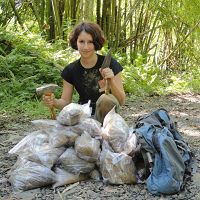Stone, DeForest & Plante, 2014
Changes in extracellular enzyme activity and microbial community structure with soil depth at the Luquillo Critical Zone Observatory
Stone, M.M., DeForest, J.L., Plante, A.F. (2014)
Soil Biology & Biochemistry
-
Luquillo, GRAD STUDENT
-
Christina, Luquillo, INVESTIGATOR, COLLABORATOR
Abstract
Highlights
- Measured C, N and P-acquiring enzymes, microbial biomass and community structure with soil depth.
- Microbial biomass, enzyme activities, carbon and nutrients decline exponentially with depth.
- Biomass-normalized specific enzyme activities either do not decline or increase significantly with depth.
- Subsoils contain metabolically active communities that are structurally distinct from surface communities.
Main Abstract
Extracellular enzymes in soils mediate the decomposition of organic matter and catalyze key transformations in carbon, nitrogen and phosphorus cycling. However, most studies of extracellular enzyme activity have focused exclusively on relatively carbon and nutrient-rich surface soils. In tropical forests, several centimeters of nutrient-rich surface soil can overlay meters of resource-poor subsoil, of which the microbial ecology is poorly characterized. The goal of this study was to determine how extracellular enzyme activity changes as a function of depth across two soil orders (Oxisols and Inceptisols) and two forest types that occur at different elevations (Tabonuco, lower elevation; Colorado, higher elevation) at the Luquillo Critical Zone Observatory in northeast Puerto Rico. We excavated three soil pits to 140 cm at four different sites representing the four soil × forest combinations, and measured potential activities of four carbon-acquiring enzymes (α-glucosidase, β-glucosidase, β-xylosidase, cellobiohydrolase), one nitrogen-acquiring enzyme (N-acetyl glucosaminidase) and one organic phosphorus-acquiring enzyme (acid phosphatase) at six discrete depth intervals. We used phospholipid fatty acid (PLFA) analysis to assess viable microbial biomass and community structure. Overall, microbial biomass, specific enzyme activities and community structure were similar across the two soil and forest types, in spite of higher carbon concentrations and C:N ratios in the Colorado forest soil. Soil nutrients, microbial biomass and potential enzyme activities all declined exponentially with depth. However, when normalized to microbial biomass, specific enzyme activities either did not change with depth (β-glucosidase, β-xylosidase, cellobiohydrolase and N-acetyl glucosaminidase) or increased significantly with depth (α-glucosidase and acid phosphatase, P < 0.05). Principal components analysis of PLFA biomarkers revealed shifts in community structure with depth (P < 0.01), driven largely by a decline in fungal:bacterial ratios, an increase in gram positive and actinobacteria biomarkers, and a decrease in gram negative biomarkers. Shifts in community structure, upregulation of enzyme production in response to resource scarcity and decreased enzyme turnover rates may all contribute to high specific enzyme activities in subsoils. Our study indicates that low-carbon tropical subsoils contain small but metabolically active microbial communities, and that specific enzyme activities can be used to examine changes in microbial physiology across orders of magnitude gradients in soil carbon concentrations.
Citation
Stone, M.M., DeForest, J.L., Plante, A.F. (2014): Changes in extracellular enzyme activity and microbial community structure with soil depth at the Luquillo Critical Zone Observatory. Soil Biology & Biochemistry. DOI: 10.1016/j.soilbio.2014.04.017
 This Paper/Book acknowledges NSF CZO grant support.
This Paper/Book acknowledges NSF CZO grant support.
Explore Further


